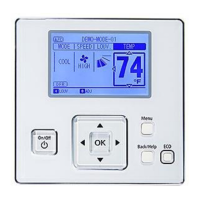System or Point Trouble Event Operation of the Control Panel
IFC-3030 Operations Manual — PN 52026:C 08/05/2005 29
2.3.4 Interpreting Type ID Codes
The Type ID code that displays in a point trouble message is related to the type and function of the
point that initiates the trouble. For example, a monitor module with a
PULL STATION Type ID code
means that the monitor module connects to a manual pull station. If the Type ID code is unfamiliar,
refer to "Software Type ID Codes" on page 63. This appendix is an alphabetical list of Type ID
codes and an explanation of each.
NO POWER SUPPLY INST The AMPS-24 (main power supply) AC fail address (base plus one) has not been correctly
entered or the loop is not installed. The AMPS-24 is not configured for “Trouble Reporting”. All
four of the main power supply addresses are not programmed for MOD TYPE=Monitor and/or
TYPE CODE LABEL=Power Monitor and/or FLASHSCAN=PS Mon.
PANEL DOOR OPEN The panel door is open.
PRINTER OFF LINE Communication loss with printer. Restore power and/or printer’s online status.
PRINTER PAPER OUT Add paper.
PROGRAM CORRUPTED The database that houses the panel’s programming is corrupt. It must be re-downloaded, or all
programming must be cleared and re-entered. Service required.
PROG MODE ACTIVATED A user is currently using the panel’s programming menus.
REMOTE DISPLAY x
NO
ANSWER
The remote display at address x is not responding.
REMOTE DISPLAY x
TROUBLE
The remote display at address x is in trouble.
SELF TEST FAILED Diagnostic test failed. Service required.
SOFTWARE MISMATCH One or more LCM software revisions do not match other LCMs, and/or the NCM is not network
version 5.0, or the LCD-160 is incompatible.
STYLE 4 SHORT x
LOOP x Service required.
STYLE 6 POS. LOOP x
There is a short circuit on the positive side of loop x. Style 6 and Style 7 are supervised methods
of communicating with addressable devices. If the control panel detects a trouble (open or short),
it will drive both ends of the loop, maintaining communication in an unsupervised method. The
latching trouble will display on the panel as a Style 6 trouble until you correct the condition and
press reset. Style 7 configuration of the SLC requires the use of M500XJ modules.
STYLE 6 NEG. LOOP x
There is a short circuit on the negative side of loop x. Style 6 and Style 7 are supervised methods
of communicating with addressable devices. If the control panel detects a trouble (open or short),
it will drive both ends of the loop, maintaining communication in an unsupervised method. The
latching trouble will display on the panel as a Style 6 trouble until you correct the condition and
press reset. Style 7 configuration of the SLC requires the use of M500XJ modules.
STYLE 6 SHORT LOOP x
Style 6 and Style 7 are supervised methods of communicating with addressable devices. If the
control panel detects a trouble (open or short), it will drive both ends of the loop, maintaining
communication in an unsupervised method. The latching trouble will display on the panel as a
Style 6 trouble until you correct the condition and press reset. Style 7 configuration of the SLC
requires the use of M500XJ modules.
SYSTEM INITIALIZATION One or more devices (detectors or modules) can not report activation. This can occur following
system startup, when exiting Walk Test, or following a device trouble of No Response.
SYSTEM TROUBLES
TROUBLE MESSAGE TYPE TROUBLE DESCRIPTION
Table 2.2 System Troubles (2 of 2)

